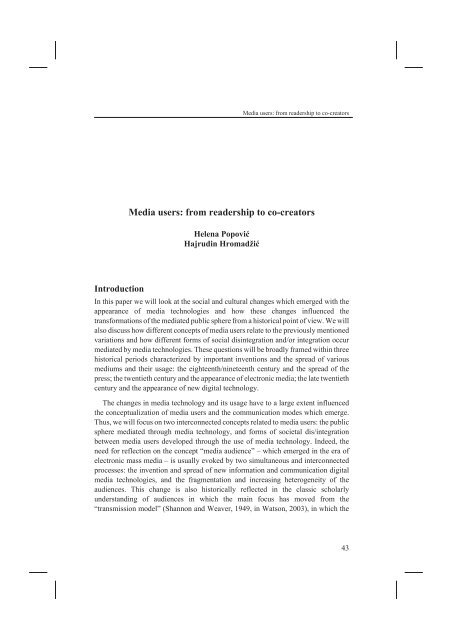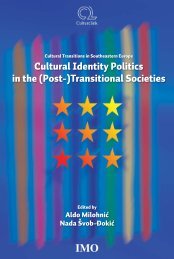D:\Documents and Settings\Ana\My Documents\Biserka-knjiga ...
D:\Documents and Settings\Ana\My Documents\Biserka-knjiga ...
D:\Documents and Settings\Ana\My Documents\Biserka-knjiga ...
You also want an ePaper? Increase the reach of your titles
YUMPU automatically turns print PDFs into web optimized ePapers that Google loves.
Introduction<br />
Media users: from readership to co-creators<br />
Helena Popoviæ<br />
Hajrudin Hromad iæ<br />
Media users: from readership to co-creators<br />
In this paper we will look at the social <strong>and</strong> cultural changes which emerged with the<br />
appearance of media technologies <strong>and</strong> how these changes influenced the<br />
transformations of the mediated public sphere from a historical point of view. We will<br />
also discuss how different concepts of media users relate to the previously mentioned<br />
variations <strong>and</strong> how different forms of social disintegration <strong>and</strong>/or integration occur<br />
mediated by media technologies. These questions will be broadly framed within three<br />
historical periods characterized by important inventions <strong>and</strong> the spread of various<br />
mediums <strong>and</strong> their usage: the eighteenth/nineteenth century <strong>and</strong> the spread of the<br />
press; the twentieth century <strong>and</strong> the appearance of electronic media; the late twentieth<br />
century <strong>and</strong> the appearance of new digital technology.<br />
The changes in media technology <strong>and</strong> its usage have to a large extent influenced<br />
the conceptualization of media users <strong>and</strong> the communication modes which emerge.<br />
Thus, we will focus on two interconnected concepts related to media users: the public<br />
sphere mediated through media technology, <strong>and</strong> forms of societal dis/integration<br />
between media users developed through the use of media technology. Indeed, the<br />
need for reflection on the concept “media audience” – which emerged in the era of<br />
electronic mass media – is usually evoked by two simultaneous <strong>and</strong> interconnected<br />
processes: the invention <strong>and</strong> spread of new information <strong>and</strong> communication digital<br />
media technologies, <strong>and</strong> the fragmentation <strong>and</strong> increasing heterogeneity of the<br />
audiences. This change is also historically reflected in the classic scholarly<br />
underst<strong>and</strong>ing of audiences in which the main focus has moved from the<br />
“transmission model” (Shannon <strong>and</strong> Weaver, 1949, in Watson, 2003), in which the<br />
43



